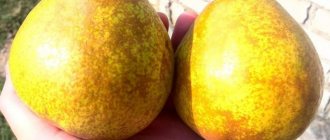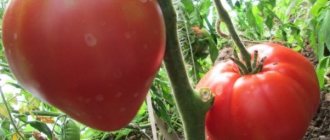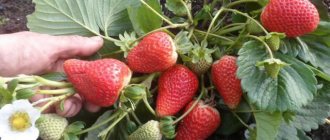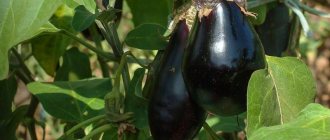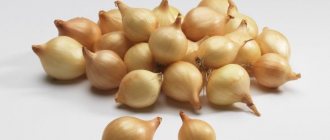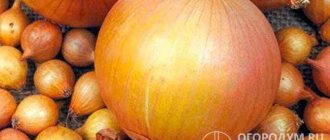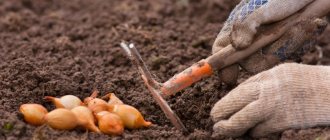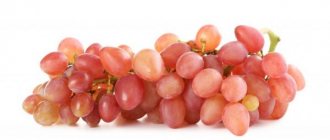There are a large number of apple tree varieties in the world. Many of them have gained popularity among gardeners due to their taste and low maintenance requirements. Breeders are working to create new varieties, but there are varieties of so-called folk selection, because these varieties are popular in many territories and for a long time that their creators no longer remember. The Borovinka apple tree is a variety of Russian folk selection. It is common in some countries and is called differently: Duchess of Oldenburg, Kharlamovka, Bravina, Kharlamovskoe, Borovitskaya. The apple tree is registered in the State Register under the name Borovinka.
Apple tree variety Borovinka.
What type does it belong to?
The Borovinka apple tree variety has gained national love and spread not only throughout Russia, but also far beyond its borders.
In each country, gardeners named the apple tree in their own way: Duchess of Oldenburg, Kharlamovka, Bravina, Kharlamovskoye, Borovitskaya.
There are many names, but there is only one variety - now we will try to understand its features by going through the main characteristics.
Borovinka is an autumn variety of apple tree that bears fruit every year starting in late summer and ending in early autumn.
But the timing of fruit ripening may vary depending on the region where the apple tree is grown.
In the southern regions, ripening dates are mid and late summer; in the middle zone - the beginning of autumn.
Autumn varieties of apple trees include: Volzhanka, Jonathan, Dessertnoye Petrova, Long (China), Zhigulevskoye, Imrus, Calvil Snezhny, Cinnamon novo, Young Naturalist, Uslada, Uspenskoye, Prima, Gift for gardeners, Pepin Saffron, Freshness, Scala, Flashlight, Screen , Amber, Aelita.
Subspecies and options
The variety has several subspecies and variants; they differ from each other in some characteristics.
Red
Borovinka Mahogany tree has medium-ripening fruits that are covered with a solid red blush. A distinctive feature of this variety is its frost resistance and ability to resist apple tree diseases. Apples weigh 100 grams.
Altai
Borovinka Altai tree is of medium height with a pyramidal crown. The apples are round, slightly flattened, weighing up to 95 grams. This variety has average yield and frost resistance.
Pineapple
Pineapple Borovinka is a winter variety; its fruits are sweeter than the usual Borovinka and are stored a little longer. The taste of apples is sweet and sour, weight up to 120 grams. The variety is resistant to scab.
creeping
The creeping form of Borovinka is grown in regions with cold winters. The seedling is placed at an angle to the ground, and is pruned so that the tree develops close to the soil; the branches are bent and tied, creating a standard-free shape, which makes it possible to cover the tree in winter and receive more heat in summer.
Creeping type of apple tree.
Caring for such an apple tree consists of removing non-fruiting branches, protecting against sunburn and covering the crown in winter.
speckled
So, in some areas they call the Borovinka variety.
Akulovskaya
The Akulovskaya apple tree is widespread in the Volga and Don regions; it is less resistant to frost and is affected by powdery mildew. The tree has a medium ripening period, the apples are green with a slight blush, weighing up to 90 grams.
Description of the Borovinka variety
Here we will describe Borovinka from the ground to the crown.
In the Borovinka variety, the tree itself can and does reach a height of over 4.5 meters.
The round, sparse crown is about 5.6 m in diameter.
The branches are quite sparsely located on the trunk; they extend from the trunk at an angle ranging from 30 to 45 degrees.
Smooth surface, slight angulation - such is their structure; Color: green with a brown tint. The bark is olive in color.
The shoots are dark brown (sometimes there is a brownish-greenish tint), the buds are well formed, the growth internodes are slightly curved, sparse, usually long.
The leaves have a wide oval shape, a short sharp tip, a glossy surface, and a dark green color.
A distinctive feature of this variety of apple trees is the characteristic depressions on the leaves (dents) with a diameter of approximately the size of a pea. Relative to the shoot, the leaves grow at an angle of almost 90 degrees.
Inflorescences - an umbrella. The flowers are medium-sized, mostly white, sometimes with a soft pinkish tint.
The pistil of the flower is small, the same size as the anthers, it is slightly fused at the base, heavily pubescent in the fork area.
Now, finding yourself in an apple orchard, you can easily distinguish Borovinka among trees of other varieties. And a couple more words about seeds and fruits so that recognition is maximized.
The regularly rounded fruits of the Borovinka variety have a smooth surface and moderately shine in the sun. The apples are quite large, slightly larger than average (weigh about 90 grams each).
IMPORTANT! Borovinki apples are large and heavy, so there are often cases when the branches do not hold them and the apples fall.
The pulp of the fruit is juicy, soft, loose, granular. Yellow coloring with pinkish streaks is rare in the fruit; it is mostly light green.
There is a slight waxy coating on the surface, while the skin of the fruit is dry and smooth.
The peduncle is usually thin and long, and the color is light green. The seeds are dark brown.
The Borovinka apple variety is good for consumption “from the branch”, directly fresh, and is also suitable for preparations, subjected to any processing (drying, processing into juices, jam, wine).
We have just found out what the apple tree looks like now, but it is worth mentioning how it became like this: the history of its creation and its distribution area.
IMPORTANT! The fruits are fast-moving and transportable, so they are preserved quite well until mid-winter.
Consumer qualities of fruits
The apples are regular in shape, without pronounced ribs, and medium in size. The weight of one fruit is approximately 100 g. The main color is greenish or yellowish with a slight pink tint; cover - in the form of a red striped blush. The skin is smooth, and numerous light subcutaneous dots are clearly visible on it. There is a slight waxy coating on the surface. The seed chambers are closed, the seeds are quite large, dark brown. The peduncle is thin and elongated.
Apples are distinguished by high commercial qualities (marketability up to 90%, including premium and first grade - up to 40-50%)
The flesh of ripe fruits is juicy, at first quite dense and crunchy, and later becomes slightly loose, yellowish in color, sweet and sour with a spicy aftertaste. The ratio of sugar and acid (sugar acid index) is 16.5 (24.5). At the stage of technical ripeness, there is a noticeable predominance of acid, but 1-2 weeks after picking, the taste becomes more balanced. According to biochemical studies of VNIISPK, the fruit contains:
| Nutrients and beneficial substances | Quantity per 100 g of product |
| Vitamin C (ascorbic acid) | 8.2-15.3 mg |
| Sahara | 9.9-11.5 g |
| Acids | 0,62-0,87% |
The fruits are for table use, most often consumed fresh, but are also suitable for drying and making juice. The harvested crop tolerates transportation well and is stored for up to 2-3 months.
Photo
Recycling
Apples can be dried, frozen, and used to make canned compotes and purees, preserves, marmalade, marmalade, and marshmallows.
By the way. In Russia, there has long been another way to prepare apples for the winter - soaking (fermentation). Apples of late varieties, small or medium-sized, light-colored, with dense flesh are suitable for it (Antonovka is the ideal choice). A detailed description of soaking (fermenting) apples and preparing wort can be easily found if desired.
“Paradise apple trees” are the trees of the same name, identified by botanists as a separate group. These are low-growing fruit trees with small apples, which are distinguished by their high yield and elegant appearance.
Place of birth and distribution
The Borovinka variety is characterized by a very extensive distribution area.
In Russia, its mass cultivation is observed in many central regions, in the Krasnodar Territory, in the Caucasus and in the Stavropol Territory.
The uniqueness of apple trees is that the variety is completely unpretentious and grows and bears fruit safely in any corner of Russia under different climatic conditions.
Now, having talked about the tree and the fruit itself, it’s time to talk about how many apples we can get from Borovinka.
Advantages and disadvantages
The Borovinka variety is valued by many gardeners, who note:
- precociousness;
- unpretentiousness;
- high productivity;
- good adaptability to different climatic conditions;
- increased winter hardiness;
- excellent marketability of fruits;
- coincidence of terms of technical and consumer maturity.
Apple trees show high, but not annual yields
Flaws:
- fruiting is periodic;
- apples are sour and have a mediocre taste;
- fruit shedding under drought conditions.
Despite its shortcomings, this old variety is still grown in many household plots throughout Russia.
Productivity
As already noted, Borovinka is an apple tree, the fruits of which ripen every year at the end of summer - beginning of autumn.
REFERENCE! Apple trees begin to bear fruit intensively around the 4th or 5-10th year, and at the age of 10 years they produce good harvests of fragrant apples (on average, 60 to 75 kg of fruit from just one tree!). When the age reaches 23 years and up to 30, you can harvest up to 200 kg from each tree.
The disadvantage of this variety is the frequency of its fruiting . Gardeners should not forget the fact that in order to harvest every year, different varieties of apple trees must grow in the garden.
Borovinka apple trees are characterized by high productivity and early fruiting.
Such fruits cannot be consumed or processed.
This is why harvesting on time is so important. Ripe fruits are usually picked at the end of August.
Of course, immediately after picking, you want to quickly eat the Borovinka apple, but it has been noticed that only after a week has passed after picking, the taste qualities are revealed most clearly.
The following varieties have high yields: Augusta, Antonovka dessert, Gala, Grushovka winter, Cinnamon striped, Papirovka, Antey, Lyubava, Kuibyshevskoe, Daughter of Pepinchik, Yablochny Spas, Bellefleur Kitayka, Phoenix Altai, Uralets, Belyi Naliv, Lobo, Yandykovskoe, Chudnoe, Welsey , Stroevskoe, Sokolovskoe, Solnyshko, Uralskoe Nalivnoe, Carpet.
Reviews
Svetlana, 41 years old, Saratov
The Borovinka variety grows in almost every garden. The tree is elegant, not very tall. The apples are beautiful, yellow-green with a bright striped blush, fragrant, and can be stored for 2-3 months, but you can eat them right away. The trees are very productive, they bear fruit every year, some years more, some less, but there are always apples. We usually eat them fresh or dry them for the winter.
Vasily, 52 years old, Orenburg
The boletus has been growing in our dacha for a long time, about thirty years. The tree is winter-hardy, tolerates frost normally, does not suffer from diseases and does not require special care. It bears fruit abundantly, in good years it happens that the branches are almost completely covered with fruits; once almost 200 kilograms were collected from the tree. We harvest in the fall, in September. The apples are not very sweet, even a little sour, but I like them. We make juice from them and cook jam for the winter.
Ksenia, 38 years old, Krasnodar region
We have several varieties of apple trees in our garden. I read that Borovinka is an old Russian variety, and I wanted to grow it. The seedling was bought ten years ago and began to bear fruit in its fifth year. The apples are sour, but juicy, and they make good juice. They are also great for drying, which I use in winter for compotes and jelly. The tree is unpretentious, does not freeze or get sick, but on hot days it needs to be watered, otherwise the fruits may fall off. Apples become tastier and more aromatic when they sit for a week or two.
Storage
After harvesting, a reasonable question arises: how to store the fruits?
Since Borovinka is an autumn apple variety, with proper care, the apples can last until the end of November - December. To do this, the fruits are placed in rows, stalk down, in cardboard boxes or wooden boxes.
It is important that the gaps between the boards are either absent or very small. The rows are laid between each other with sawdust from deciduous trees. It is also possible to store them in plastic bags suspended from the ceiling of the cellar.
If you do not yet have Borovinka apple trees growing in your garden, but you have already planned to purchase seedlings, then the following information will come in handy.
Growing in regions
For successful cultivation in the regions, it is important to apply certain agrotechnical measures.
Growing apple trees in the Urals.
Ural
The Borovinka apple tree was brought to this region in the mid-20th century to provide residents of the Urals with locally produced fruits. At first it was planned to grow the apple tree in a slate form, but in the process of zoning, the apple tree in a standard form adapted to the local climate. The most common apple tree is the Red Borovinka, which has higher frost resistance than the ordinary Borovinka.
Siberia
In Siberia there are high frosts in winter, so trees need additional protection. Gardeners use protective mats and other available means for covering. For cultivation in this region, the slate form of the Borovinka apple tree is recommended.
Republic of Belarus
The climatic conditions of Belarus are suitable for growing apple trees. The Borovinka variety in this region does not require any special measures. Compliance with the basic requirements of planting and care is enough for the tree to grow well and bear fruit.
Planting and care
Let's consider three main questions when purchasing seedlings:
Seedlings of this variety are planted in spring or autumn. It is important to be in time before the first frosts manifest themselves on the ground or in the air.
In most cases, when choosing seedlings, preference is given to two-year-old plants.
Choosing a location: the first criterion is sufficient lighting.
But the tree bark can be damaged by excessive sunlight, which is why seedlings of this variety of apple trees are planted in places where direct sunlight is exposed to several hours a day.
The soil. The Borovinka apple tree prefers moisture-absorbing soil. Loamy, sandy loam and floodplain soils are suitable for it, as well as leached chernozems.
Boletus can also be cultivated on sandy soils, but with good care (periodic application of fertilizers). The soil must be slightly acidic - pH 5.6...6.0.
Soil preparation. Manure and humus, in our case, are excellent fertilizers for the land.
Planting seedlings. The soil must fill the root system completely; the soil must be trampled down with your foot.
When planting in the ground, it is unacceptable to bury the apple tree seedling. The root collar (the place where the root passes into the trunk) must be 5-7 cm above ground level.
A newly planted tree needs to be watered with 2-3 buckets of water.
Having planted a plant, we must not forget about caring for it.
Borovina is absolutely unpretentious and is not demanding in caring for itself. But there is also a significant drawback: the apple tree has poor drought resistance, that is, during drought, unripe fruits are dropped.
That is why it is necessary to direct the growth of apple trees in the right direction.
It is necessary to install supports under the branches covered with fruits , or tie the branches of the tree together in order to prevent their death individually or the death of the tree as a whole.
IMPORTANT! The wood on plants of this apple variety is extremely brittle. With a rich harvest, tree branches easily break under the load of fruit, often leading to the short life of the apple tree.
To set fruit, apple trees need pollen from another plant. If your neighbors do not have an apple tree of a different variety on their property or in your garden, purchase one immediately.
After all, when a pollinator appears, the yield increases significantly even in self-fertile varieties.
In spring, the apple tree should be fed. Fertilizing in the fall is also possible; be sure to use various complex fertilizers WITHOUT nitrogen . On sandy soils, mainly poor ones, fertilizers should be applied annually , and on rich lands frequent fertilizing should not be abused.
IMPORTANT: from 80 to 100% of flowers must be picked off in the first year after planting. This improves the survival rate of the tree.
In the future, even at the greenfly stage, it is necessary to pick off up to half of the crop - exclusively established fruits, the size of which is within a few centimeters in diameter. This operation is called “harvest rationing.”
Thanks to it, the tree will be better prepared for winter, the remaining hanging fruits will be sweeter when ripe and will grow to a larger size.
When watering an apple tree, the following arithmetic applies: 4-5 times a month, twice a day, one bucket of water should be used per adult tree.
When fruiting begins, and this is July-August, good watering is extremely important.
If there is not enough moisture during this period, then crop losses are possible not only this year, but also next year.
Watering should be stopped in August. Otherwise, the growth of shoots may be protracted; this can only have a negative effect on the winter hardiness of the tree.
However, if the year turns out to be dry, then continued watering is extremely necessary - this helps the tree to absorb moisture in the required amount. Naturally, depending on the weather, the watering regime will also be adjusted.
Apple tree Borovinka is a frost-resistant variety . However, to protect the young tree from early unexpected frosts or snowless winters, mulching with horse humus is used in the tree trunk area.
When talking about caring for an apple tree, harmful external influences, such as pests and diseases, are highlighted as a separate item.
Peculiarities
The Borovinka variety grows in sunny places with moisture-permeable fertile soils; it does not tolerate drought.
Landing
Apple trees are grown from seeds or seedlings. A plant grown from seeds is used as a rootstock for growing varietal crops.
A two-year-old seedling is taken for planting; planting can be done in the spring, before the sap begins to flow, and in the fall, after the leaves fall, but 2 - 3 weeks before the onset of frost.
The site for planting is chosen to be sunny, although the apple tree tolerates light shade, with fertile, moisture-permeable soil, which may be slightly acidic.
To plant a seedling in the spring, the planting hole is prepared in the fall, and if in the fall, then the hole is prepared 2 - 3 weeks before planting. The size of the hole depends on the size of the roots, but usually it is 0.7 meters deep and 1 meter in diameter. If the soil on the site is poor, then it needs to be fertilized with humus, peat or complex mineral fertilizers. At the bottom, a drainage is made from crushed stone or expanded clay 15 cm thick; a stake is driven into the middle of the hole for stability, to which the seedling is tied after it is planted and watered. The root collar of the plant should remain 5–7 cm above the soil surface.
Useful video on how to plant a seedling correctly.
Growing
The Borovinka apple tree does not tolerate dry periods well, the yield may decrease and the taste of the fruit will deteriorate. Therefore, during drought, special attention should be paid to watering.
Agricultural technology
During drought, the tree needs watering, and during the rainy season, it is important to loosen the tree trunk and remove weeds. After pruning, the sections are treated with garden varnish, the trunk is whitened with lime in the fall, and the tree trunk circles are dug up, fertilizing the tree with humus or compost.
Pruning and crown formation.
After planting, the seedling is shortened by 1/3, after such pruning the tree begins to form a crown.
Apple tree pruning diagram.
Sanitary pruning is carried out in the spring, before the buds open and the sap begins to flow, and in the fall after harvesting, dry, damaged and diseased branches are removed.
For the crown, 3 to 5 strong branches are selected, which are shortened, and the rest are removed. In subsequent years, the crown is thinned out and branches growing deep into the tree, crooked and weak shoots are removed.
It is recommended to remove up to 25% of the crown in one pruning, otherwise the tree will suffer.
Diseases and pests
Gardeners appreciate that Borovinka is moderately resistant to pests and various diseases. However, sometimes it is severely damaged by scab. But proper prevention and treatment with fungicides will prevent scab from ruining the harvest.
The previously mentioned M.V. Rytov in 1862, according to Lodygin, gave the following description at one time: “... They say very correctly that Borovinka is one of the most common varieties of apples in central Russia; This variety is not very respected, probably because these apples cannot compare with Antonovka and are valued much cheaper; Apart from fresh consumption, they are of no use and are not so good when eaten; tenants, however, do not neglect Borovinka as a cheap apple, which always has good sales locally. It would be more correct to recognize Borovinka apples as suitable only for undemanding tastes.”
Undoubtedly, there are some shortcomings, but the Borovinka variety is the most valuable of the “starter” crops for breeding. About two dozen new modern varieties were created not without the participation of the apple tree described above: Volga Beauty, Podruga, Zimneye Polosatoe, Zhigulevskoe and others.
If you find an error, please select a piece of text and press Ctrl+Enter.
History of the variety
The apple tree has several names by which summer residents distinguish it. The most common and frequently used, including in the State Register, is Borovinka. The exact place of origin is unknown. Some sources suggest that this is a variety of folk selection, and it was bred by a Tula gardener who bore the last name Bravin. Some suggest that these apples were named so because they grew in a forest. In the 1870s, the scientist Rytvin described them as unfit for food. And the first description of the variety was given by Bolotov at the beginning of the 19th century.
How to grow an apple tree in the garden
You need to choose the right place, select a seedling and plant a tree. Otherwise, the planting process is no different from other fruit crops.
Seedling preparation
It is advisable to purchase 2-year-old planting material. Buy it in advance, preferably in the fall. Since many people plan to plant in the spring, the plant must be properly preserved. It is buried in the garden or lowered into the basement. The roots are first dipped in a mixture of mullein and clay.
Before planting, place them in a solution for several hours to stimulate root growth.
Required soil
The Borovinka apple tree grows on any soil, but feels better on black soil, loam or sandy loam soil. Before digging, humus and mineral fertilizers are added.
Planting dates and scheme
Before sap flow begins, planting material must be planted in the ground. The distance between trees is 5-6 m, between rows 7 m. The pit is prepared large, dimensions 70-80 cm deep, 100 cm in diameter. Fill with a mixture of earth, peat and river sand. Then a mound is formed, a seedling is placed on it, sprinkled with earth up to the root collar.
See also
Characteristics and description of the Richard apple tree variety, frost resistance and applicationRead

